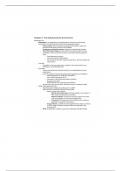Chapter 2: The Global Business Environment
Globalization 2-2
- Globalization: The integration and interdependence of economic, technological,
sociocultural, and political systems across diverse geographic regions.
- Roman empire: Various territories that absorbed the empire’s culture and
products and served as a source of raw materials
- Portuguese and Spanish empires: Sixteenth and seventeenth centuries
- Dutch East India Company: an association of merchants meant to reduce
competition, achieve economies of scale, and increase trade throughout the
world.
- First multinational company
- First to issue stock to shareholders
- Had the right to build forts, maintain armed forces, and form treaties with
native princes
- Post WWI
- Devastation of the war caused many countries to look inward and focus on
self-reliance, not international trade
- Post WWII
- Leading economists and politicians pushed for more globalization and less
protectionism
- Led to the creation of several international trade agreements and institutions
- General Agreement on Tariffs and Trade (GATT)
- World Trade Organization (WTO)
- Association of South East Asian Nations (ASEAN)
- European Union (EU)
- North American Free Trade Agreement (NAFTA)
- Promote open trade among nations and better access to investment capital
- Global Trade Agreements 2-2a
- World Bank and the INternational Monetary Fund (IMF)
- GATT formed as a temporary measure to lower tariffs
- Based on three main principles
- Most favored nation status: tariff rate granted to one member of
GATT would be extended to all members
- National treatment: Foreign firms would be subject to the same
rules and regulations as a country’s domestic firms.
- Consensus: Trade disputes would be settled by the unanimous
agreement of all parties to the dispute.
- Uruguay Round: cut tariffs and created agreements in areas as varied as
services, capital, intellectual property, textiles, and agriculture, also
launched WTO
- WTO: an organization created to supervise and liberalize international trade
, - Formed to deal with the rules of trade between nations and is responsible
for negotiating and implementing new trade agreements as well as
policing member countries’ adherence to them.
World trade and Free-Trade Associations 2-2b
- World trade: defined by the value of the world’s merchandise exports
- Supported through a series of free trade agreements negotiated between various
countries and overseen by the WTO
- Europe has the highest concentration of trade
- Africa has the lowest concentration of trade
- European Union
- 1950s: Europeans were searching for a way to promote political and economic
stability in their region
- Maastricht Treaty: established the legal framework for the EU
- Created a single market run by a system of laws that applies to all member
states, guaranteeing the freedom of movement of people, goods, services, and
capital
- 1999: common currency, Euro
- Designed to help build a single market by easing travel of citizens and
goods, eliminating exchange rate problems, providing price transparency,
creating a single financial market, and supporting price stability and low
interest rates.
- NAFTA
- 1994: NAFTA came into effect when the US, Canada, and Mexico signed the
treaty to eliminate tariffs among each other.
- Total trade between the US and its NAFTA partners has increased by 208%
- Open borders for many industries, maintains restrictions on some agricultural
products, and forms the largest trading block in the world in terms of its members’
combined GDPS.
- ASEAN
- 1967: Established to support three primary goals for the region
- Accelerating economic growth
- Promoting social and cultural development
- Ensuring peace and stability
- Five original members: Indonesia, Malaysia, the Philippines, Singapore, and
Thailand
- Since then: Brunei Darussalam, Cambodia, Laos, Myanmar, Vietnam
- Trade in the region is lower than within the EU and NAFTA due to diversity
- Members have agreed to promote enhanced trade liberalization through the
creation of the ASEAN Economic Community (AEC)
- AEC: Designed to create a freer flow of goods, services, and investments
within the region.
- Trade with China has more than tripled, but trade with US has stagnated
- MERCOSUR
- Comprises the countries of Argentina, Brazil, Paraguay, Uruguay, and Venezuela




